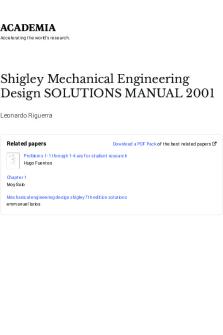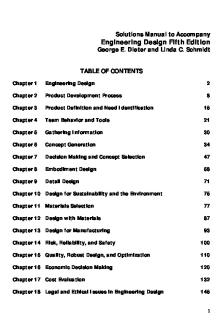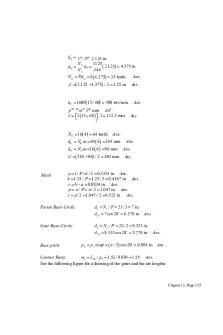Shigley's Mechanical Engineering Design 10th Edition Solutions Manual Budynas Nisbett PDF

| Title | Shigley's Mechanical Engineering Design 10th Edition Solutions Manual Budynas Nisbett |
|---|---|
| Author | Lane Price |
| Pages | 23 |
| File Size | 475.1 KB |
| File Type | |
| Total Downloads | 138 |
| Total Views | 603 |
Summary
Shigley's Mechanical Engineering Design 10th Edition Budynas Solutions Manual Completed download: https://testbankreal.com/download/shigleys-mechanical-engineering-design- 10th-edition-solutions-manual-budynas-nisbett/ Chapter 2 2-1 From Tables A-20, A-21, A-22, and A-24c, (a) UNS G10200 HR: Sut...
Description
Shigley's Mechanical Engineering Design 10th Edition Budynas Solutions Manual Completed download: https://testbankreal.com/download/shigleys-mechanical-engineering-design10th-edition-solutions-manual-budynas-nisbett/
Chapter 2 From Tables A-20, A-21, A-22, and A-24c, (a) UNS G10200 HR: Sut = 380 (55) MPa (kpsi), Syt = 210 (30) MPa (kpsi) Ans. (b) SAE 1050 CD: Sut = 690 (100) MPa (kpsi), Syt = 580 (84) MPa (kpsi) Ans. (c) AISI 1141 Q&T at 540C (1000F): Sut = 896 (130) MPa (kpsi), Syt = 765 (111) MPa (kpsi) Ans. (d) 2024-T4: Sut = 446 (64.8) MPa (kpsi), Syt = 296 (43.0) MPa (kpsi) Ans. (e) Ti-6Al-4V annealed: Sut = 900 (130) MPa (kpsi), Syt = 830 (120) MPa (kpsi) Ans. ______________________________________________________________________________
2-1
2-2
(a) Maximize yield strength: Q&T at 425C (800F) Ans.
(b) Maximize elongation: Q&T at 650C (1200F) Ans. ______________________________________________________________________________ Conversion of kN/m3 to kg/ m3 multiply by 1(103) / 9.81 = 102 AISI 1018 CD steel: Tables A-20 and A-5 3 S y 370 10 47.4 kN m/kg Ans. 76.5 102 2011-T6 aluminum: Tables A-22 and A-5 3 S y 169 10 Ans. 62.3 kN m/kg 26.6 102 Ti-6Al-4V titanium: Tables A-24c and A-5 830 103 Sy Ans. 187 kN m/kg 43.4 102 ASTM No. 40 cast iron: Tables A-24a and A-5.Does not have a yield strength. Using the ultimate strength in tension 3 Sut 42.5 6.89 10 Ans 40.7 kN m/kg 70.6 102 ______________________________________________________________________________ 2-3
2-4
Shigley’s MED, 10th edition
Chapter 2 Solutions, Page 1/22
AISI 1018 CD steel: Table A-5 6 E 30.0 10 106 106 in 0.282 2011-T6 aluminum: Table A-5 6 E 10.4 10 106 106 in 0.098
Shigley’s MED, 10th edition
Ans.
Ans.
Chapter 2 Solutions, Page 2/22
Ti-6Al-6V titanium: Table A-5 6 E 16.5 10 103 106 in Ans. 0.160 No. 40 cast iron: Table A-5 6 E 14.5 10 55.8 106 in Ans. 0.260 ______________________________________________________________________________ 2-5 2G (1 v) E
v
E 2G 2G
Using values for E and G from Table A-5, 30.0 2 11.5 Steel: v 0.304 Ans. 2 11.5 The percent difference from the value in Table A-5 is 0.304 0.292 0.0411 4.11 percent 0.292
Ans.
10.4 2 3.90 0.333 Ans. 2 3.90 The percent difference from the value in Table A-5 is 0 percent Ans.
Aluminum:
v
Beryllium copper:
v
18.0 2 7.0 2 7.0
0.286
Ans.
The percent difference from the value in Table A-5 is 0.286 0.285 0.00351 0.351 percent 0.285
v
14.5 2 6.0
0.208 2 6.0 The percent difference from the value in Table A-5 is
Gray cast iron:
Ans.
Ans.
0.208 0.211 0.0142 1.42 percent Ans. 0.211 ______________________________________________________________________________
2-6
(a) A0 = (0.503)2/4 = 0.1987 in2, = Pi / A0
Shigley’s MED, 10th edition
Chapter 2 Solutions, Page 3/22
For data in elastic range, = l / l0 = l / 2 A l l l0 l For data in plastic range, 1 0 1 l0 l0 l0 A On the next two pages, the data and plots are presented. Figure (a) shows the linear part of the curve from data points 1-7. Figure (b) shows data points 1-12. Figure (c) shows the complete range. Note: The exact value of A0 is used without rounding off. (b) From Fig. (a) the slope of the line from a linear regression is E = 30.5 Mpsi
Ans.
From Fig. (b) the equation for the dotted offset line is found to be
= 30.5(106) 61 000
(1) The equation for the line between data points 8 and 9 is = 7.60(105) + 42 900 (2) Solving Eqs. (1) and (2) simultaneously yields = 45.6 kpsi which is the 0.2 percent offset yield strength. Thus, Sy = 45.6 kpsi Ans. The ultimate strength from Figure (c) is Su = 85.6 kpsi
Ans.
The reduction in area is given by Eq. (2-12) is R
A0 Af A0
100
Data Point
Pi
1 2 3 4 5 6 7 8 9 10 11 12 13 14 15 16 17
0
1000 2000 3000 4000 7000 8400 8800 9200 8800 9200 9100 13200 15200 17000 16400 14800
Shigley’s MED, 10th edition
0.1987 0.1077 100 45.8 % 0.1987
0
0
0.0004 0.0006 0.001 0.0013 0.0023 0.0028 0.0036 0.0089 0.1984 0.1978 0.1963 0.1924 0.1875 0.1563 0.1307 0.1077
0.00020 0.00030 0.00050 0.00065 0.00115 0.00140 0.00180 0.00445 0.00158 0.00461 0.01229 0.03281 0.05980 0.27136 0.52037 0.84506
0 5032 10065 15097 20130 35227 42272 44285 46298 44285 46298 45795 66428 76492 85551 82531 74479
l, Ai
Ans.
Chapter 2 Solutions, Page 4/22
50000 y = 3.05E+07x - 1.06E+01
Stress (psi)
40000 30000 Series1
20000
Linear (Series1)
10000 0 0.000
0.001
0.001
0.002 Strain
Stress (psi)
(a) Linear range 50000 Y 45000 40000 35000 30000 25000 20000 15000 10000 5000 0 0.000 0.002 0.004 0.006 0.008 0.010 0.012 0.014 Strain
(b) Offset yield 90000 80000
U
Stress (psi)
70000 60000 50000 40000 30000 20000 10000 0 0.0
0.1
0.2
0.3
0.4
0.5
0.6
0.7
0.8
0.9
Strain
(c) Complete range Shigley’s MED, 10th edition
Chapter 2 Solutions, Page 5/22
(c) The material is ductile since there is a large amount of deformation beyond yield. (d) The closest material to the values of Sy, Sut, and R is SAE 1045 HR with Sy = 45 kpsi, Sut = 82 kpsi, and R = 40 %. Ans. ______________________________________________________________________________ 2-7
To plot true vs., the following equations are applied to the data. P true A Eq. (2-4) l ln for 0 l 0.0028 in (0 P 8 400 lbf ) l0
ln where
A0
(0.503)2
A0 A
for l 0.0028 in
(P 8 400 lbf )
0.1987 in 2
4 The results are summarized in the table below and plotted on the next page. The last 5 points of data are used to plot log vs log The curve fit gives
m = 0.2306 log 0 = 5.1852 0 = 153.2 kpsi
Ans.
For 20% cold work, Eq. (2-14) and Eq. (2-17) give, A = A0 (1 – W) = 0.1987 (1 – 0.2) = 0.1590 in2
A0 0.1987 ln 0.2231 0.1590 A Eq. (2-18): S y 0 m 153.2(0.2231)0.2306 108.4 kpsi
ln
Ans.
Eq. (2-19), with Su 85.6 from Prob. 2-6, Su
Su 85.6 107 kpsi 1 W 1 0.2
Shigley’s MED, 10th edition
Ans.
Chapter 2 Solutions, Page 6/22
P 0 1 000 2 000 3 000 4 000 7 000 8 400 8 800 9 200 9 100 13 200 15 200 17 000 16 400 14 800
Shigley’s MED, 10th edition
l 0 0.000 4 0.000 6 0.001 0 0.001 3 0.002 3 0.002 8
A 0.198 7 0.198 7 0.198 7 0.198 7 0.198 7 0.198 7 0.198 7 0.198 4 0.197 8 0.196 3 0.192 4 0.187 5 0.156 3 0.130 7 0.107 7
0 0.000 2 0.000 3 0.000 5 0.000 65 0.001 15 0.001 4 0.001 51 0.004 54 0.012 15 0.032 22 0.058 02 0.240 02 0.418 89 0.612 45
true 0 5 032.71 10 065.4 15 098.1 20 130.9 35 229 42 274.8 44 354.8 46 511.6 46 357.6 68 607.1 81 066.7 108 765 125 478 137 419
log -3.699 -3.523 -3.301 -3.187 -2.940 -2.854 -2.821 -2.343 -1.915 -1.492 -1.236 -0.620 -0.378 -0.213
log true 3.702 4.003 4.179 4.304 4.547 4.626 4.647 4.668 4.666 4.836 4.909 5.036 5.099 5.138
Chapter 2 Solutions, Page 7/22
______________________________________________________________________________ 2-8
Tangent modulus at = 0 is
E
5000 0 25 106 psi 3 0.2 10 0
Ans.
At = 20 kpsi
Shigley’s MED, 10th edition
Chapter 2 Solutions, Page 8/22
26 19 103 14.0 106 psi E20 3 1.5 1 10 (10-3) 0 0.20 0.44 0.80 1.0 1.5 2.0 2.8 3.4 4.0 5.0
Ans.
(kpsi) 0 5 10 16 19 26 32 40 46 49 54
______________________________________________________________________________ 2-9
W = 0.20, (a) Before cold working: Annealed AISI 1018 steel. Table A-22, Sy = 32 kpsi, Su = 49.5 kpsi, 0 = 90.0 kpsi, m = 0.25, f = 1.05 After cold working: Eq. (2-16), u = m = 0.25 A0 1 1 Eq. (2-14), 1.25 Ai 1 W 1 0.20 A Eq. (2-17), i ln 0 ln1.25 0.223 u Ai Eq. (2-18),
S y 0 im 90 0.223
Eq. (2-19),
Su
(b) Before:
Su 49.5 1.55 32 Sy
0.25
61.8 kpsi
Su 49.5 61.9 kpsi 1 W 1 0.20
After:
Ans. 93% increase
Ans. 25% increase
Su 61.9 1.00 S y 61.8
Ans.
Ans.
Ans.
Lost most of its ductility. ______________________________________________________________________________ 2-10 W = 0.20, (a) Before cold working: AISI 1212 HR steel. Table A-22, Sy = 28 kpsi, Su = 61.5 kpsi, 0 = 110 kpsi, m = 0.24, f = 0.85 After cold working: Eq. (2-16), u = m = 0.24
Shigley’s MED, 10th edition
Chapter 2 Solutions, Page 9/22
Eq. (2-14), Eq. (2-17), Eq. (2-18), Eq. (2-19),
(b) Before:
A0 1 1 1.25 Ai 1 W 1 0.20 A i ln 0 ln1.25 0.223 u Ai
S y 0 im 110 0.223 76.7 kpsi Ans. 174% increase S 61.5 Su u 76.9 kpsi Ans. 25% increase Ans. 1 W 1 0.20 0.24
Su 61.5 2.20 28 Sy
After:
Su 76.9 1.00 S y 76.7
Ans.
Ans.
Lost most of its ductility. ______________________________________________________________________________ 2-11 W = 0.20, (a) Before cold working: 2024-T4 aluminum alloy. Table A-22, Sy = 43.0 kpsi, Su = 64.8 kpsi, 0 = 100 kpsi, m = 0.15, f = 0.18 After cold working: Eq. (2-16), u = m = 0.15 A0 1 1 Eq. (2-14), 1.25 Ai 1 W 1 0.20 A Eq. (2-17), Ans. i ln 0 ln1.25 0.223 f Material fractures. Ai ______________________________________________________________________________ 2-12 For HB = 275, Eq. (2-21), Su = 3.4(275) = 935 MPa Ans. ______________________________________________________________________________ 2-13 Gray cast iron, HB = 200. Eq. (2-22), Su = 0.23(200) 12.5 = 33.5 kpsi
Ans.
From Table A-24, this is probably ASTM No. 30 Gray cast iron Ans. ______________________________________________________________________________ 2-14 Eq. (2-21), 0.5HB = 100 HB = 200 Ans. ______________________________________________________________________________
Shigley’s MED, 10th edition
Chapter 2 Solutions, Page 10/22
2-15 For the data given, converting HB to Su using Eq. (2-21) HB 230 232 232 234 235 235 235 236 236 239
Su (kpsi) 115 116 116 117 117.5 117.5 117.5 118 118 119.5
Su = 1172
Eq. (1-6) Su
S
u
N
Su2 (kpsi) 13225 13456 13456 13689 13806.25 13806.25 13806.25 13924 13924 14280.25 Su2 = 137373
1172 117.2 117 kpsi Ans. 10
Eq. (1-7), 10
sSu
S
2 u
NSu2
137373 10 117.2
2
Ans. 1.27 kpsi N 1 9 ______________________________________________________________________________ i 1
2-16 For the data given, converting HB to Su using Eq. (2-22) Su (kpsi) 40.4 40.86 40.86 41.32 41.55 41.55 41.55 41.78 41.78 42.47
Su2 (kpsi) 1632.16 1669.54 1669.54 1707.342 1726.403 1726.403 1726.403 1745.568 1745.568 1803.701
Su = 414.12
Su2 = 17152.63
HB 230 232 232 234 235 235 235 236 236 239
Shigley’s MED, 10th edition
Chapter 2 Solutions, Page 11/22
Eq. (1-6) Su
S
u
N
414.12 41.4 kpsi Ans. 10
Eq. (1-7), 10
s Su
S
2 u
NSu2
17152.63 10 41.4
uR
45.62 34.7 in lbf / in 3 2(30)
2
Ans. 1.20 N 1 9 ______________________________________________________________________________ i 1
2-17 (a) Eq. (2-9)
Ans.
(b) A0 = (0.5032)/4 = 0.19871 in2
L
P 0 1 000 2 000 3 000 4 000 7 000 8 400 8 800 9 200 9 100 13 200 15 200 17 000 16 400 14 800
A
(A0 / A) – 1
0 0.000 4 0.000 6 0.001 0 0.001 3 0.002 3 0.002 8 0.003 6 0.008 9 0.196 3 0.192 4 0.187 5 0.156 3 0.130 7 0.107 7
0.012 28 0.032 80 0.059 79 0.271 34 0.520 35 0.845 03
= P/A0
0 0.000 2 0.000 3 0.000 5 0.000 65 0.001 15 0.001 4 0.001 8 0.004 45 0.012 28 0.032 80 0.059 79 0.271 34 0.520 35 0.845 03
0 5 032. 10 070 15 100 20 130 35 230 42 270 44 290 46 300 45 800 66 430 76 500 85 550 82 530 74 480
From the figures on the next page, 5 1 uT Ai (43 000)(0.001 5) 45 000(0.004 45 0.001 5) 2 i 1 1 45 000 76 500 (0.059 8 0.004 45) 2 81 000 0.4 0.059 8 80 000 0.845 0.4
66.7 103 in lbf/in 3
Shigley’s MED, 10th edition
Ans.
Chapter 2 Solutions, Page 12/22
Shigley’s MED, 10th edition
Chapter 2 Solutions, Page 13/22
2-18, 2-19 These problems are for student research. No standard solutions are provided. ______________________________________________________________________________ 2-20 Appropriate tables: Young’s modulus and Density (Table A-5)1020 HR and CD (Table A20), 1040 and 4140 (Table A-21), Aluminum (Table A-24), Titanium (Table A-24c) Appropriate equations: F F For diameter, Sy A / 4 d 2
d
4F Sy
Weight/length = A, Cost/length = $/in = ($/lbf) Weight/length, Deflection/length = /L = F/(AE) With F = 100 kips = 100(103) lbf,
Young's Material Modulus units Mpsi 1020 HR 1020 CD 1040 4140 Al Ti
Density lbf/in3
30 30 30 30 10.4 16.5
0.282 0.282 0.282 0.282 0.098 0.16
Yield Weight/ Strength Cost/lbf Diameter length kpsi $/lbf in lbf/in 30 57 80 165 50 120
0.27 0.30 0.35 0.80 1.10 7.00
2.060 1.495 1.262 0.878 1.596 1.030
0.9400 0.4947 0.3525 0.1709 0.1960 0.1333
Cost/ Deflection/ length length $/in in/in 0.25 0.15 0.12 0.14 0.22 $0.93
1.000E-03 1.900E-03 2.667E-03 5.500E-03 4.808E-03 7.273E-03
The selected materials with minimum values are shaded in the table above. Ans. ______________________________________________________________________________ 2-21
First, try to find the broad category of material (such as in Table A-5). Visual, magnetic, and scratch tests are fast and inexpensive, so should all be done. Results from these three would favor steel, cast iron, or maybe a less common ferrous material. The expectation would likely be hot-rolled steel. If it is desired to confirm this, either a weight or bending test could be done to check density or modulus of elasticity. The weight test is faster. From the measured weight of 7.95 lbf, the unit weight is determined to be
w
7.95 lbf W 0.281 lbf/in 3 Al [ (1 in) 2 / 4](36 in)
which agrees well with the unit weight of 0.282 lbf/in3 reported in Table A-5 for carbon steel. Nickel steel and stainless steel have similar unit weights, but surface finish and darker coloring do not favor their selection. To select a likely specification from Table A-20, perform a Brinell hardness test, then use Eq. (2-21) to estimate an ultimate strength Shigley’s MED, 10th edition
Chapter 2 Solutions, Page 14/22
of Su 0.5H B 0.5(200) 100 kpsi . Assuming the material is hot-rolled due to the rough surface finish, appropriate choices from Table A-20 would be one of the higher carbon steels, such as hot-rolled AISI 1050, 1060, or 1080. Ans. ______________________________________________________________________________ 2-22
First, try to find the broad category of material (such as in Table A-5). Visual, magnetic, and scratch tests are fast and inexpensive, so should all be done. Results from these three favor a softer, non-ferrous material like aluminum. If it is desired to confirm this, either a weight or bending test could be done to check density or modulus of elasticity. The weight test is faster. From the measured weight of 2.90 lbf, the unit weight is determined to be W 2.9 lbf w 0.103 lbf/in 3 2 Al [ (1 in) / 4](36 in)
which agrees reasonably well with the unit weight of 0.098 lbf/in3 reported in Table A-5 for aluminum. No other materials come close to this unit weight, so the material is likely aluminum. Ans. ______________________________________________________________________________ 2-23
First, try to find the broad category of material (such as in Table A-5). Visual, magnetic, and scratch tests are fast and inexpensive, so should all be done. Results from these three favor a softer, non-ferrous copper-based material such as copper, brass, or bronze. To further distinguish the material, either a weight or bending test could be done to check density or modulus of elasticity. The weight test is faster. From the measured weight of 9 lbf, the unit weight is determined to be
w
9.0 lbf W 0.318 lbf/in 3 2 Al [ (1 in) / 4](36 in)
which agrees reasonably well with the unit weight of 0.322 lbf/in3 reported in Table A-5 for copper. Brass is not far off (0.309 lbf/in3), so the deflection test could be used to gain additional insight. From the measured deflection and utilizing the deflection equation for an end-loaded cantilever beam from Table A-9, Young’s modulus is determined to be
100 24 Fl 3 17.7 Mpsi E 3Iy 3 (1) 4 64 (17 / 32) 3
which agrees better with the modulus for copper (17.2 Mpsi) than with brass (15.4 Mpsi). The conclusion is that the material is likely copper. Ans. ______________________________________________________________________________ 2-24 and 2-25 These problems are for student research. No standard solutions are provided. ______________________________________________________________________________ 2-26 For strength, = F/A = S Shigley’s MED, 10th edition
A = F/S
Chapter 2 Solutions, Page 15/22
For mass, m = Al = (F/S) l Thus,
f 3(M ) = /S , and maximize S/ ( = 1)
In Fig. (2-19), draw lines parallel to S/
The higher strength aluminum alloys have the greatest potential, as determined by comparing each material’s bubble to the S/ guidelines. Ans. ______________________________________________________________________________ 2-27 For stiffness, k = AE/l A = kl/E For mass, m = Al = (kl/E) l =kl2 /E Thus,
f 3(M) = /E , and maximize E/ ( = 1)
In Fig. (2-16), draw lines parallel to E/
Shigley’s MED, 10th edition
Chapter 2 Solutions, Page 16/22
From the list of ma...
Similar Free PDFs
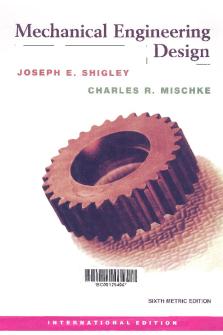
Mechanical engineering design
- 6 Pages
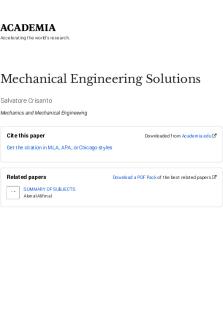
Mechanical Engineering Solutions
- 21 Pages

MECHANICAL ENGINEERING REVIEW MANUAL
- 509 Pages

MECHANICAL ENGINEERING REVIEW MANUAL
- 509 Pages
Popular Institutions
- Tinajero National High School - Annex
- Politeknik Caltex Riau
- Yokohama City University
- SGT University
- University of Al-Qadisiyah
- Divine Word College of Vigan
- Techniek College Rotterdam
- Universidade de Santiago
- Universiti Teknologi MARA Cawangan Johor Kampus Pasir Gudang
- Poltekkes Kemenkes Yogyakarta
- Baguio City National High School
- Colegio san marcos
- preparatoria uno
- Centro de Bachillerato Tecnológico Industrial y de Servicios No. 107
- Dalian Maritime University
- Quang Trung Secondary School
- Colegio Tecnológico en Informática
- Corporación Regional de Educación Superior
- Grupo CEDVA
- Dar Al Uloom University
- Centro de Estudios Preuniversitarios de la Universidad Nacional de Ingeniería
- 上智大学
- Aakash International School, Nuna Majara
- San Felipe Neri Catholic School
- Kang Chiao International School - New Taipei City
- Misamis Occidental National High School
- Institución Educativa Escuela Normal Juan Ladrilleros
- Kolehiyo ng Pantukan
- Batanes State College
- Instituto Continental
- Sekolah Menengah Kejuruan Kesehatan Kaltara (Tarakan)
- Colegio de La Inmaculada Concepcion - Cebu


